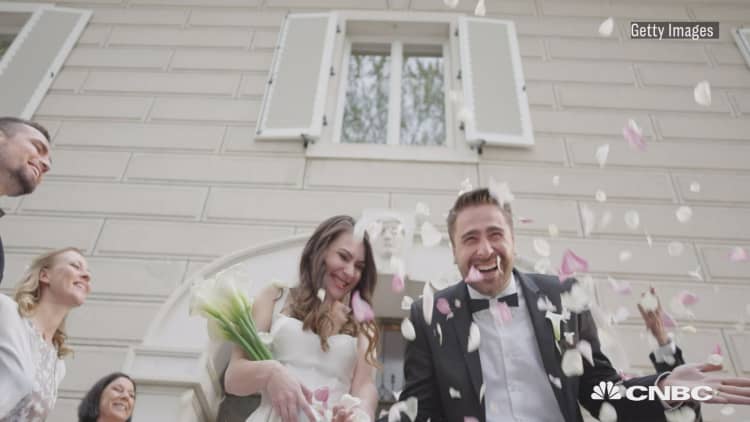Tens of thousands of people's financial futures have been thrown into question when they were denied public service loan forgiveness.
The program allows certain not-for-profit and government employees to have their federal student loans canceled after 10 years of payments.
One in 4 American workers are in public service and could, in theory, be eligible, according to the Consumer Financial Protection Bureau. But last year, the bureau reported that student loan servicers are failing to guide borrowers to the consumer protection, mostly by not informing them of what they need to do to qualify.
As a result, just 96 people out of the nearly 30,000 who applied to be released from their debt have been approved. (2017 was the first year people could qualify for forgiveness, since it requires 10 years of payments and the program began in 2007.)
CNBC has found and interviewed some of the lucky people who have successfully navigated the government program. While these borrowers offer hope, they also underscore the program's flaws.
"To have a student loan system where to receive the benefits you have to be perfect is not a reasonable expectation to set up for 43 million borrowers," said Persis Yu, director of the Student Loan Borrower Assistance Project at the National Consumer Law Center, a nonprofit advocacy group.
Here are some of the many, many people for whom the program has failed.
Jason Edwards has been a full-time professor at a state university for more than a decade. He recently wrote a book on former President Bill Clinton's foreign policy rhetoric, and he runs a personal finance blog.
Still, he can't figure out public service loan forgiveness.
In 2006, Edwards graduated from Georgia State University with a doctorate in communications and around $100,000 in student loans.
About a year into the repayment of his loans, he switched from the standard 10-year repayment plan to an extended repayment plan, which lowers the borrower's monthly payments but stretches out their repayment timeline. That made sense for him because, as a professor just starting his career, his salary was not high.
When he learned in 2013 that he was a candidate for public service loan forgiveness, he was ecstatic. His student loans would be paid off within a decade, rather than 25 years. But then the bad news came — even though he worked in a public service job, and held federal loans, the extended repayment plan he'd enrolled in disqualified him from the relief. "It's painful," Edwards, 45, said. More than a decade after graduating, he still owes around $50,000.
There's some 14 ways to repay your student loans but, to qualify for public service loan forgiveness, you need to be enrolled in one of these four income-driven repayment plans:
- Income-contingent repayment
- Income-based repayment
- Pay-as-you-earn repayment
- Revised pay-as-you-earn repayment
(The standard repayment plan also qualifies, but under it you'd have paid off your loans in 10 years, anyway.)
Edwards soon switched into a qualifying income-driven repayment plan, but the clock on his 10 years to forgiveness was reset. Years of payments had been thrown away.
Then, a ray of hope. Congress authorized a $350 million "fix" to the public service loan forgiveness program earlier this year, which gave people who had been enrolled in graduated or extended repayment plans another shot at qualifying. He's already applied, and been denied, though he believes he's eligible and is battling it out with the Education Department. "I will not give up," Edwards said.
After her divorce, Jane Leven returned to school in her late 40s to get her master's degree in library science. She graduated from the University of Pittsburgh in 2008 with around $45,000 in student loans.
The public service loan forgiveness program was on her radar from the beginning. "I was very excited because I knew I was going to be doing public service for the rest of my life," Leven said.
She has worked as a branch manager at a library, as well as the head of IT at another. "It's a marvelous place to work," Leven said. "It's one of the few places where it's welcome to all."
In 2016, two years before she'd be at the 10-year mark of the program, she went to confirm that she was on track for the forgiveness. She was not, she learned. None of her payments had counted. She had a Federal Family Education Loan, which does not qualify for the program.
Other loans that don't qualify for PSLF: federal Perkins loans, private loans or any noneducation loans. Only direct loans are eligible. You can check which loans you're holding at StudentLoans.gov.
She immediately consolidated her debt into direct loans, but had to restart the 10 years all over again, like Edwards.
"It absolutely floored me," Leven said, adding that she had no idea there were different types of federal student loans. "My whole future disintegrated."
The 57-year-old has just $25,000 saved for retirement, and was banking on the relief to redirect her $300-a-month student loan bill to her small nest egg.
"I don't know when I'll be able to retire," she said.
These are the public service loan forgiveness requirements. Often, if you don't meet one of them, you can make changes so that you do.
- Your loans must be federal direct loans.
- Your employer must be a government organization at any level, a 501(c)(3) not-for-profit organization or some other type of not-for-profit organization that provides public service.
- By the end, you need to have made 120 qualifying, on-time payments in an income-driven repayment plan or the standard repayment plan.
Have your own student loan saga? We want to hear from you. Please email: annie.nova@nbcuni.com
More from Personal Finance
These are the ways student loans stop people from buying a house
Student loan nightmare: Some borrowers have to start over
People with massive student debt hope Trump will let them declare bankruptcy



